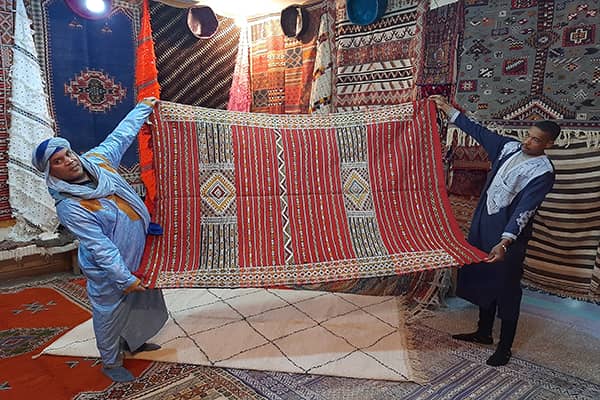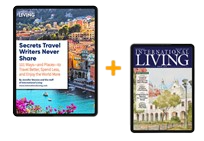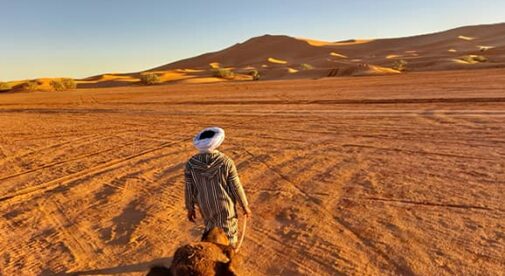Thick snowflakes belted against the frosted windshield of our black Range Rover, adding to the growing accumulation on the wildly winding, single-lane highway speeding along underneath us. I asked our guide, Hamza, whether this was a normal occurrence. “In this part of the county, at this time of year (December)…yes, it is,” he exclaimed, much to my bewilderment.
Bewildered because we were still in Morocco. In Africa. Where we were taught as schoolchildren that it was always hot and arid. Where locals wore little clothing because the sun was so scorching hot. But here we were, trekking our way through the sub-Atlas Mountains, surrounded by evergreens, and a landscape that looked…well, astonishingly like the cold, snowy Canada we were hoping so desperately to escape. (Although the paved roads, surprisingly, were in better shape than their pothole-ridden counterparts back in Ontario!)
We passed a local who was busily sculpting a lion from the snow at the side of the highway, a Moroccan flag flying triumphantly atop its head. The artist, dressed to brave any Canadian winter, with ski pants, a winter parka, and a toque, added finishing decorative touches to his 5’x12’ creation, using just a small hand spade.

Did I mention we had passed a ski resort just a few minutes before discovering his snow monster? (Yes, Mrs. Royce [my 4th-grade teacher], we need to have a few words!)
We had left Fez earlier that morning, embarking upon a three-day trek to Marrakech, through majestic mountain ranges and enough desert sand to form a million sparkling gold beaches. Hamza, a mild-mannered, slightly built Moroccan man with a stylishly trimmed beard, claimed to know each grain of Saharan sand by name. The perfect driver to lead our version of the “Marrakech Express.”
Continuing through the low-rising Middle Atlas Mountains, we burrowed our way through sprawling fields of olive trees and droves of feather-leafed carob trees, and towering cedars (which Moroccans harvest for cabinets and oils). As we passed through forests coated with a dusting of snow, Beverley spotted a family of Barbary macaques swinging amongst the trees. When we pulled off the road for a closer look, dozens of their brethren descended from snow-covered rocks and trees—all looking for edible treats (apparently conditioned from other well-meaning tourists).
Unlike the monkeys at the top of the Rock of Gibraltar, these primates seemed tamer and gentler. They hesitantly approached to quickly snatch peanuts and bananas from our hands with their long, slender fingers, then suddenly retreated, seemingly studying us from a safe distance. Watching monkeys run through falling snow was not a sight we had ever anticipated enjoying in Morocco, so it was a rather magical moment.
The nearby town of Ifrane is yet another contradiction to pre-conceived notions about Africa. Designed and built by the French back in the 1930s, their goal was to create a town resembling a Swiss alpine ski resort. Popular with tourists, both international and domestic, this town exudes a strong European flair. The cobblestone streets, outdoor patios, and tall, black street lamps lead the imagination back to 1930s Paris.
A stone carving of a lion, now considered a town landmark, sits across the street from Hotel Chamonix in the center of this clean, well-manicured town. Sculpted by a German prisoner of war during the Second World War, it commemorates Ifrane’s last remaining king of the jungle—killed here a hundred years ago. It now sits as an iconic selfie-magnet, surrounded by a botanical park, luxury hotels, and trendy cafes.
Heading farther down the highway, we passed through Er-Rachidia, a military town with a modern landscape and many residential and retail developments currently underway. Initially created to house the French Foreign Legion, the military base maintains a very imposing presence. Nowadays, soldiers remain stationed at this mammoth compound to monitor the Algerian border—on the other side of the neighboring mountains.
The landscape quickly morphed from snow-covered evergreen forests to reddish-brown tracts of barren desert sand, as the snow-capped peaks of the High Atlas Mountains suddenly popped majestically from the background. The windshield framed this cinematographer’s dream as though it was a museum-quality masterpiece.
We stopped for lunch in Midelt, a colorful and relatively modernized town that sits between the Middle and High Atlas Mountains, known to locals as “the apple place”—famous for both the red and green varieties. But, instead of apples, Beverley and I feasted on chicken. For two ¼ chicken dinner plates, with rice, fries, bread, teas, and coffees, our combined bill was $6.40. (A comparable meal in Canada would easily have set us back $50, so we splurged and bought a couple of apples from a roadside vendor to enjoy as dessert.)

The landscape continued to change as we plunged deeper into the desert terrain. Palms and date trees replaced the evergreens, roadside sellers of fossils sprung up like ants on jelly, and cliffsides became pale-brown rocky canyons.
As twilight descended upon us, Hamza, seeming suddenly possessed by uncontrollable exuberance, drove off the paved road, accelerating into the desert terrain—kicking up showers of sand as we barreled through its barren landscape.
Berber villages, with compilations of old clay buildings and tents, were scattered across the desert landscape, surrounded by a mishmash of different species of cacti that would require a botanist to identify. What caught our eyes the most, however, were the caravans of camels—or rather, dromedaries (the single-humped variety), gathered at the rustic villages our tires sprayed with sand.
This was it. We were arriving at a Berber village at Erg Chebbi, where the most anticipated adventure of our trip was about to occur—a camel, er…dromedary, sunset ride across the golden sand dunes of Africa’s legendary Sahara Desert.

Glistening dunes of seemingly sculpted sand rose around us, as though a painting had come to life. The windswept waviness of the desert’s smooth sandy curves seemed almost unreal, too perfect to be true. And as the hooves of our one-humped dromedaries sank into the soft sand, ever so slightly, with each bouncing step, the adventure felt even more cinematic. The Arabic chants of the call to prayer began echoing from the distance, just as the sun painted the sky vivid wavelengths of red and orange hues above us, like a cascade of fire. Beverley and I looked at one other and smiled knowingly: Our lives had become a movie. We were finally living the dream—the stuff that most people plan to do, “one day.”
This was our reward for putting aside all of the excuses and making it happen.
Our Berber guide, Salah, adorned in a haik (a robe similar to a toga), and a wrapped cloth turban, led us—or rather, our dromedaries—on an excursion across the sandy dunes for almost an hour before stopping for a break. After dismounting, we promptly kicked off our boots and ran barefoot through the soft, warm, Cappuccino-colored sand—kicking it up to celebrate our freedom like excited little school kids. Perhaps it was a case of mind over matter, or maybe it was magical sand, but I instantly felt 30 years younger as I repeatedly leaped four feet into the air, lifting my knees to my chin.
We climbed a tall dune to watch the culmination of the most visually compelling sunset we had ever witnessed, then slid back down the hill as though we were taking a toboggan ride.
On our way back to the village, Salah pointed out Giant Milkweed plants, a type of evergreen shrub common throughout the south Moroccan Sahara. Its leaves secrete a white liquid, nicknamed “Sahara milk”, which is poisonous and can lead to blindness and even death if consumed. “Far more dangerous than snakes,” Salah warned serpent-wary Beverley.
We were welcomed back at the village by Moha, another Berber tribesman who offered us some mint tea—commonly referred to as “Berber whiskey”—on an outside patio underneath a starlit sky, while our meal was being prepared.
The bountiful feast presented to us in their dining tent could have fed a small army. Which was good, since I had worked up the appetite of one. Plentiful platters of chicken, potatoes, tomatoes, and zucchini were accompanied by traditional Moroccan harira soup (a spicy vegetable soup). Dessert included a plate of freshly harvested pomegranates and tangerines—served with all the “Berber whiskey” and coffee we could consume.
Following supper, Salah and Moha invited us to a live fireside music show—starring them. By the glow of the bonfire, the two men beat their drums in a trance-inducing rhythm, while chanting and humming in melodic accompaniment. The men seemed completely entranced by their own music, their hearts and souls so captivated that our presence seemed unnoticed. It seemed clear that they were not performing for us, but rather we were witnessing a ritual of musical passion.
When the fire burned out, we were wished a goodnight and directed to our tent. But first, Salah insisted, we must go observe the night sky over the desert. Alone, he said, because it was “most romantic.”
It was good advice.
The brilliant sky opened above us as though we were rocketing through the galaxy in a spaceship. I’ve never seen a night sky so packed with radiant stars that seemed within reach. It might have been romantic—if not for the fact that we were both frozen in awe waiting to be engulfed by the universe descending upon us.
We set our alarms to awaken before the sun—mindful not to miss another opportunity to enjoy nature’s colorful palette. This time, we encountered Nomads—a tribe that wanders the desert without any permanent home. Thinking, at first, that they were Berbers from our host village, we negotiated for some fossilized trinkets they were hawking, as we posed for some group photos. It wasn’t until Salah arrived with our dromedaries in tow, to take us on a morning ride, that their nomadic colors were revealed. (Apparently, Nomads wander these sands daily, seeking out touristic customers.)
Following our early ride, I bid Jowls (a nickname I had bestowed upon my saggy beast), and our gracious Berber hosts, a fond farewell, as we hopped back into Hamza’s Range Rover to continue our road trek to Marrakech.
We stopped at the nearby village of Rissani, Morocco’s oldest town—and one that seems to have been time-warped back to biblical days. Traffic through town was considered gridlocked as four men riding donkeys proceeded down its main dirt road at once, their empty saddle bags announcing their arrival to do business at the open market.
The market was abuzz with vendors, all eager to sell their wares to the scarce shoppers. Stalls were packed with cured meats, seafood, mountains of spices, fresh fruit, and veggies. Blacksmiths hammered on old-school anvils, while shoemakers sold boots and sandals that they swore would last the owner “a lifetime.”

A barren landscape continued along the road stretching toward the High Atlas Mountains, although it was dotted with thousands of dirt mounds resembling gigantic ant hills. Hamza pulled over so I could examine some, explaining that they were structures built by the Berbers, all connected to an underground canal used to collect ground water. Creative, skillful, and enterprising people, these Berbers!
We had almost reached the looming High Atlas Mountains (which had teased us like the proverbial end of the rainbow) when we took another time out to explore Ourarzazate, home of the world-renowned Atlas Film Studios. Established in 1983, at 150 hectares it’s the largest film studio (by size) in the world. Popular movies and shows such as Gladiator, Jewel of the Nile, The Mummy, Babel, Aladdin (with Will Smith), Prison Break, and Game of Thrones have been filmed on this site. The guided tour lasts only 45 minutes, but you’re free to explore the sets—and take geeky selfies, completely unsupervised, once the tour is finished. Similarly, a Kasbah with meandering laneways leading to a spectacular hillside lookout point in nearby Ait Benhaddou may appear familiar to fans of Jewel of the Nile, Gladiator, and Lawrence of Arabia, since all were filmed there.
The final stretch of our journey led us straight through the High Atlas Mountains, affording some truly magnificent views of the country’s spectacular topography from their dizzying heights. It was a perfect ending to a wonderfully inspiring three-day adventurous trek through Morocco’s mountains, forests, villages, and deserts.
Now, in Marrakech, a storied city of snake charmers, monkey handlers, palm-lined streets, and labyrinth-style souks, a new adventure was surely awaiting us.
Follow David and Beverley’s adventures here.

Get Your Free Report on the World’s Best Places to Retire:
Learn more about the best places in the world to retire in our daily postcard e-letter.
Simply enter your email address below to sign up for our free daily postcards and we’ll also send you a FREE report on The World’s Top 10 Retirement Havens, plus access to over 10 more free reports. Our gift to you, on our favorite destinations.
Related Articles
The World’s Best Places to Retire
10 Things I Need in My “Overseas Paradise”
Is Morocco A Retirement Destination?
Upcoming Conferences
The Only 2024 Fast Track Panama Conference
If your dream retirement involves stunning beaches… lush green mountains… a warm climate with no hurricanes… first-rate healthcare… incredible value for money (a couple can live well on $2,200 a month)… and the World’s #1 Retiree Discount Program…
Join our Panama experts and expats in February and discover why Panama could be your perfect paradise.
REGISTER NOW, SEATS LIMITED: EARLY BIRD DISCOUNT HERE



.png)